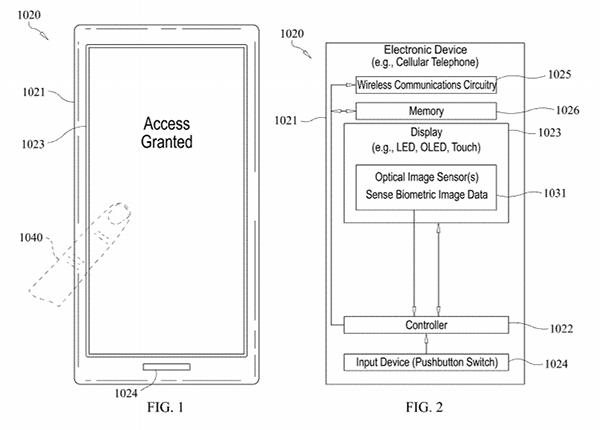Apple has been granted a patent that could point to the company adding Touch ID to phones that don’t have Home buttons. The fingerprint sensor would likely be placed beneath the display, just as some Android phone makers already do.
The patent relates to a way for fingerprints to be read optically, rather than capacitively as is the case with existing Touch ID systems. The current MacBook Pro and MacBook Air notebooks use capacitive readers like iPhones, but the recently released 16-inch MacBook Pro uses an optical reader. Just like the one that could be used in an iPhone’s display.

In fact, the illustrations that Apple provided for the patent application show exactly that. And it even outlines it in the related text, too.
As will be appreciated by those skilled in the art, if the display is in the form of a touch display, the touch display may operate as both an input device and a display. As such, the display would cooperate with the controller to perform one or more device functions in response to input. For example, a device function may include a powering on or off of the electronic device, initiating communication via the wireless transceiver, and/or performing a menu function based upon input to the touch display.
The controller may change the display to show a menu of available applications based upon pressing or input to the touch display. Of course, other device functions may be performed based upon input to the touch display. Other or additional finger-operated user input devices may be carried by the portable housing, for example, a pushbutton switch, which may alternatively or additionally be used for device functions as will be appreciated by those skilled in the art.
An optical image sensor is carried by the housing under the display. The optical image sensor senses biometric image data associated with a user, such as, for example, data representative of a biometric image of the fingerprint patterns of the user’s finger. The controller may perform an authentication function by matching the acquired biometric image data to the stored biometric template data stored in the memory, for example. The controller may perform and/or restrict functionality of the electronic device based upon the authentication as will be appreciated by those skilled in the art. In some embodiments, there may be more than one optical image sensor.

While it’s possible that Apple could replace Face ID with a new Touch ID implementation, it’s more likely that both will be used in the future. The two methods have their differences as well as their own positives and negatives, so the use of both would cover all bases. What that would do to the potential cost of future iPhones is unclear at this point, however.
(Source: USPTO)
You may also like to check out:
- Download: iOS 13.3 Final IPSW Links, OTA Update And iPadOS 13.3 For Compatible Devices
- Download: iOS 13.3.1 Beta 1 OTA Profile, IPSW Links Released For iPhone And iPad
- Downgrade iOS 13.3 To iOS 13.2.3 For Checkra1n Jailbreak, Here’s How
- Jailbreak iOS 13.3 Using Checkra1n, Here’s How [Guide]
- Download Checkra1n iOS 13.3 Jailbreak IPA, Here’s How [0.9.7 beta]
- iOS 13 / 13.2.2 Jailbreak Tweaks Compatibility List For Checkra1n
- Gold iPhone 11 Pro Max: Case, Lightning Cable, Wireless Charger, Band, Speaker, More
- Red iPhone 11 Accessories: Case, Lightning Cable, Wireless Charger, Band, Speaker, Much More
- Yellow iPhone 11 Accessories: Case, Lightning Cable, Qi Wireless Charger, Band, Speaker, Much More
- Purple iPhone 11 Accessories: Case, Lightning Cable, Qi USB Charger, Band, Speaker, Much More
- Green iPhone 11 Accessories: Case, Lightning Cable, Qi USB Charger, Band, Speaker, Much More
- Midnight Green iPhone 11 Pro Max: Case, Lightning Cable, Wireless Charger, Band, Speaker, More
- Apple Watch ECG App Hack: Enable Outside US In Unsupported Country On Series 5 & 4 Without Jailbreak
You can follow us on Twitter, or Instagram, and even like our Facebook page to keep yourself updated on all the latest from Microsoft, Google, Apple, and the Web.

